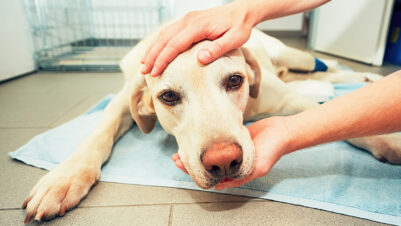Method for predicting recovery following thoracolumbar hemilaminectomy
Daniel Low and others, Frank Pet Surgeons, Leeds
Thoracolumbar intervertebral disc extrusion (IVDE) is a common cause of acute spinal cord injury and pelvic limb dysfunction in dogs. The severity of the injury and the resulting functional outcomes will vary. The authors used machine learning algorithms to predict the recovery of ambulation in 162 dogs following decompressive surgery for acute IVDE. The method was used in a retrospective analysis of records from 162 dogs that were deep-pain-negative following acute injury. Their findings show that electronic health records can be used to train accurate machine learning algorithms that stand up well to internal validation. The authors’ XGBoost algorithm demonstrated a well-balanced predictive performance using tabular data. Further investigations are needed to investigate whether the same algorithm may be used as a preoperative tool to guide surgical decision making.
Veterinary Surgery, 54, 665-674
Aetiology and clinical features of tremors in cats
Theofanis Liatis and others, Royal Veterinary College, Potters Bar
The clinical appearance and underlying causes of tremors are well studied in dogs, but there is little information on the equivalent condition in cats. The authors conducted a retrospective examination of the clinical records of 105 cats with tremors seen at a university hospital between 2004 and 2023. The most common diagnoses associated with tremors in cats were degenerative encephalopathy (19 cases), feline infectious peritonitis (17), congenital portosystemic shunt (17), intoxication (16) and polyneuropathy (8). More research is required to investigate the associations between clinical variables, along with prospective studies involving conscious electromyography to further characterise tremors in feline patients.
The Veterinary Journal, 309, 106292
Magnetic resonance imaging findings in dogs with steroid-responsive meningitis-arteritis
Bryn Jones and others, Anderson-Moores Veterinary Specialists, Winchester
Steroid-responsive meningitis-arteritis is a systemic immune-modulated disease causing inflammatory lesions, usually in the meninges and arteries of the spinal cord. The condition is most frequently seen in young dogs aged 6 to 18 months, typically resulting in spinal hyperaesthesia, cervical rigidity, a stilted gait and pyrexia. The authors examined the magnetic resonance imaging (MRI) findings in 53 dogs presenting at six UK referral centres. The most common features were paravertebral muscle changes, meningeal contrast enhancement and spinal cord parenchyma T2-W hyperintensity. Haemorrhage was seen in five cases and, along with T2-W hyperintensity, was shown to be significantly linked with paresis/paralysis. Relapse occurred in 9 of 29 (31 percent) of dogs for which there was adequate follow-up data.
Journal of Small Animal Practice, 66, 33-42
Survival of intracranial meningioma cases treated with radiotherapy or surgery
Rachel Geiger and others, Texas A&M University, College Station
Meningioma has been the most commonly diagnosed brain tumour in most studies published on canine patients. Surgery and radiotherapy, both individually and together, have been shown to be efficacious in extending a patient’s survival. The authors report a retrospective study comparing the effects of those two treatment modalities in 285 dogs with presumed intracranial meningioma, treated at 11 specialty clinics in three countries. There was a median survival after surgery of 297 days compared with 696 days in patients receiving radiotherapy. The size and location of the lesion did not appear to influence survival. Overall, the study showed that dogs with suspected intracranial meningioma had substantially improved survival after radiotherapy compared to surgery.
Journal of Veterinary Internal Medicine, 39, e70011
Effects of ageing on advanced imaging results in Dachshunds with disc disease
Amber Giles and others, Animal Referral Hospital, Brisbane, Queensland
Dachshunds have been shown to make up roughly half of all dogs presenting with acute paraparesis and paraplegia due to intervertebral disc extrusion (IVDE). Three advanced imaging modalities – non-contrast computed tomography (CT), CT myelography and MRI – have been extensively used for investigations into this condition. The authors compared the findings in a retrospective analysis of 150 cases of Dachshunds with IVDE. They found that non-contrast CT was effective in diagnosing IVDE in 94.7 percent of dogs under nine years old but only 56.0 percent of those aged nine years and over. The reduced visibility of disc extrusions in older Dachshunds meant that these patients more frequently required the use of CT myelography and MRI studies.
Australian Veterinary Journal, 103, 171-176
Severe neurological weakness in a seven-year-old domestic shorthair
Manka Menchetti and others, San Marco Veterinary Clinic, Veggiano, Italy
A seven-year-old female cat was referred for evaluation of an acute onset condition involving a reluctance to jump and walk. Clinical signs had been apparent for two days and were becoming progressively worse. In this “What is your diagnosis?” article, the authors describe the results of their clinical examination, which included severe flaccid tetraparesis, exercise-induced fatigue, cervical ventroflexion and reduced spinal reflexes. Serum biochemistry showed elevated serum creatine kinase, and urinalysis revealed severe proteinuria with a urine protein/creatinine ratio of 12.6mg/dl. A whole-body CT scan showed no relevant abnormalities. The authors concluded that the patient had a case of immune-mediated polymyositis and began treatment with 1.5mg/kg prednisone daily and physiotherapy. After a few days of treatment, the cat’s neurological signs began to improve and by six weeks, it was considered to be fully recovered.
Journal of the American Veterinary Medical Association
Diagnosis and treatment of a migrating foreign body in the spine of a rabbit
Margaret Cook and others, Colorado State University, Fort Collins
Traumatic spinal cord injury resulting from the migration of foreign objects has been described in dogs and cats, but not previously in rabbits. The authors describe a case in a 1.5-year-old male mixed-breed rabbit that presented with hyporexia, lethargy and reluctance to move. Radiographic images revealed a linear, radio-opaque structure extending through the oral cavity and spinal canal, and into the caudodorsal soft tissues of cervical vertebra 1. Fluoroscopy was used to triangulate the position of the object, which was removed through a 2cm dorsolateral incision. This was found to be a standard sewing needle. The patient was semi-comatose for four hours after surgery and was given mannitol to reduce swelling of the surrounding tissue. It was discharged three days later with only minor neurological abnormalities.
Journal of Exotic Pet Medicine, 50, 9-14
Neurological complications after surgical treatment of patent ductus arteriosus
Sarah Manzoni and others, Groupe Veterinaire, Liege, Belgium
Patent ductus arteriosus is the most common congenital heart defect in dogs, and if untreated it is likely to result in pulmonary hypertension and congestive heart failure. Surgical attenuation of the persistent foetal vessel has a survival rate of up to 95 percent. The authors investigated the incidence of, and risk factors for, left-sided laryngeal paralysis following surgery. They examined the records from 40 procedures – in each case, the patient survived the procedure and full closure of the aberrant vessel was achieved. Post-operative left-sided laryngeal paralysis occurred in five dogs, but this complication did not appear to be linked to left vagus nerve retraction. They recommend that endoscopic evaluation of laryngeal function after surgical ligation of patent ductus arteriosus should be performed in cases with post-operative evidence of inspiratory stridor, vocal changes, exercise intolerance or regurgitation.











